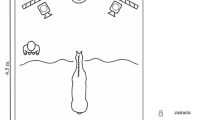Abstract
This study has shown that domestic horses are capable of cross-modal recognition of familiar humans. It was demonstrated that horses are able to discriminate between the voices of a familiar and an unfamiliar human without seeing or smelling them at the same moment. Conversely, they were able to discriminate the same persons when only exposed to their visual and olfactory cues, without being stimulated by their voices. A cross-modal expectancy violation setup was employed; subjects were exposed both to trials with incongruent auditory and visual/olfactory identity cues and trials with congruent cues. It was found that subjects responded more quickly, longer and more often in incongruent trials, exhibiting heightened interest in unmatched cues of identity. This suggests that the equine brain is able to integrate multisensory identity cues from a familiar human into a person representation that allows the brain, when deprived of one or two senses, to maintain recognition of this person.


Similar content being viewed by others
References
Adachi I (2009) Cross-modal representations in primates and dogs: a new framework of recognition of social objects. Interact Stud 10(2):225–251
Adachi I, Fujita K (2007) Cross-modal representation of human caretakers in squirrel monkeys. Behav Process 74(1):27–32
Adachi I, Kuwahata H, Fujita K (2007) Dogs recall their owner’s face upon hearing the owner’s voice. Anim Cogn 10:17–21
Bacher LF, Smotherman WP (2004) Systematic temporal variation in the rate of spontaneous eye blinking in human infants. Dev Psychobiol 44(2):140–145
Basile M, Boivin S, Boutin A, Blois-Heulin C, Hausberger M, Lemasson A (2009) Socially dependent auditory laterality in domestic horses (Equus caballus). Anim Cogn 12:611–619. doi:10.1007/s10071-009-0220-5
Birke L, Hockenhull J, Creighton E, Pinno L, Mee J, Mills D (2011) Horses’ responses to variation in human approach. Appl Anim Behav Sci 134:56–63
Boivin X, Nowak R, Despres G, Tournadre H, Le Neidre P (1997) Discrimination between shepherds by lambs reared under artificial conditions. J Anim Sci 75:2892–2898
Calvert GA (2001) Crossmodal processing in the human brain: insights from functional neuroimaging studies. Cereb Cortex 11(12):1110–1123
Cohen LB (2004) Uses and misuses of habituation and related preference paradigms. Infant Child Dev 13:349–352
Desimone R (1991) Face-selective cells in the temporal cortex of monkeys. J Cogn Neurosci 3:1–8
Ekesbo I (2011) Farm animal behaviour: characteristics for assessment of health and welfare. CABI, Wallingford/Cambridge, MA
Engh AL, Hoffmeier RR, Cheney DL, Seyfarth RM (2006) Who, me? Can baboons infer the target of vocalizations? Anim Behav 71:381–387
Evinger C (1995) A brain stem reflex in the blink of an eye. News Physiol Sci 10:147–153
Evinger C, Shaw MD, Peck CK, Manning KA, Baker R (1984) Blinking and associated eye movements in humans, guinea pigs, and rabbits. J Neurophysiol 52(2):323–339
Evinger C, Manning KA, Sibony PA (1991) Eyelid movements: mechanisms and normal data. Investig Ophthalmol Vis Sci 32(2):387–400
Fureix C, Jego P, Sankey C, Hausberger M (2009) How horses (Equus caballus) see the world: humans as significant “objects”. Anim Cogn 12:643–654
Hanggi EB, Ingersoll JF (2009) Long-term memory for categories and concepts in horses (Equus caballus). Anim Cogn 12:451–462
Hausberger M, Roche H, Henry S, Visser EK (2008) A review of the human–horse relationship. Appl Anim Behav Sci 109:1–24
Henry S, Hemery D, Richard MA, Hausberger M (2005) Human–mare relationships and behaviour of foals towards humans. Appl Anim Behav Sci 93:341–362
Henry S, Richard-Yris MA, Hausberger M (2006) Influence of various early human-foal interferences on subsequent human-foal relationship. Dev Psychobiol 48(8):712–718
Krueger K, Flauger B (2011) Olfactory recognition of individual competitors by means of faeces in horse (Equus caballus). Anim Cogn 14:245–257. doi:10.1007/s10071-010-0358-1
Krueger K, Flauger B, Farmer K, Maros K (2011) Horses (Equus caballus) use human local enhancement cues and adjust to human attention. Anim Cogn 14:187–201
Lemasson A, Boutin A, Boivin S, Blois-Heulin C, Hausberger M (2009) Horse (Equus caballus) whinnies: a source of social information. Anim Cogn 12:693–704. doi:10.1007/s10071-009-0229-9
Maros K, Gácsi M, Miklósi A (2008) Comprehension of human pointing gestures in horses. Anim Cogn 11(3):457–466
McKinley J, Sambrook TD (2000) Use of human-given cues by domestic dogs (Canis familiaris) and horses (Equus caballus). Anim Cogn 3:13–22
Pascalis O, Bachevalier J (1998) Face recognition in primates: a cross-species study. Behav Process 43:87–96
Peirce JW, Leigh AE, daCosta APC, Kendrick KM (2001) Human face recognition in sheep: lack of configurational coding and right hemisphere advantage. Behav Process 55:13–26
Proops L, McComb K (2010) Attributing attention: the use of human-given cues by domestic horses (Equus caballus). Anim Cogn 13:197–205. doi:10.1007/s10071-009-0257-5
Proops L, McComb K, Reby D (2009) Cross-modal individual recognition in domestic horses (Equus caballus). Proc Natl Acad Sci 106(3):947–951
Proops L, Walton M, McComb K (2010) The use of human-given cues by domestic horses, Equus caballus, during an object choice task. Anim Behav 79:1205–1209. doi:10.1016/j.anbehav.2010.02.015
Rybarczyk P, Koba Y, Rushen J, Tanida H, de Passille AM (2001) Can cows discriminate people by their faces? Appl Anim Behav Sci 74:175–189
Sankey C, Richard-Yris MA, Henry S, Fureix C, Nassur F, Hausberger M (2010a) Reinforcement as a mediator of the perception of humans by horses (Equus caballus). Anim Cogn 13:753–764. doi:10.1007/s10071-010-0326-9
Sankey C, Richard-Yris MA, Leroy H, Henry S, Hausberger M (2010b) Positive interactions lead to lasting positive memories in horses, Equus caballus. Anim Behav 79:869–875
Sankey C, Henry S, André N, Richard-Yris MA, Hausberger M (2011) Do horses have a concept of person? PLoS ONE 6(3):e18331. doi:10.1371/journal.pone.0018331
Sliwa J, Duhamel JR, Pascalis O, Wirth S (2011) Spontaneous voice-face identity matching by rhesus monkeys for familiar conspecifics and humans. Proc Natl Acad Sci 108(4):1735–1740. doi:10.1073/pnas.1008169108
Somppi S, Törnqvist H, Hänninen L, Vainio O, Krause C (2010) Dogs do look at images: eye tracking in canine cognition research. Faculty of Veterinary Medicine, Helsinki. http://www.vetmed.helsinki.fi/hyvinvointikeskus/dokumentit/Dogs_eyetracking.pdf. Accessed 15 July 2011
Søndergaard E, Jago J (2010) The effect of early handling of foals on their reaction to handling, humans and novelty, and the foal-mare relationship. Appl Anim Behav Sci 123:93–100
Stone SM (2010) Human facial discrimination in horses: can they tell us apart? Anim Cogn 13:51–61. doi:10.1007/s10071-009-0244-x
Tanida H, Nagano Y (1998) The ability of miniature pigs to discriminate between a stranger and their familiar handler. Appl Anim Behav Sci 56:149–159
Waring GH (2003) Horse behaviour, 2nd edn. Noyes Publications/William Andrew Publishing, Norwich/New York, pp 92, 253
Acknowledgments
We are grateful to Robert S. Jones. As manager and owner of “Seventh Heaven Farm,” Harrisonburg, Virginia, he made the experiment possible in 2010–2011.
Author information
Authors and Affiliations
Corresponding author
Rights and permissions
About this article
Cite this article
Lampe, J.F., Andre, J. Cross-modal recognition of human individuals in domestic horses (Equus caballus). Anim Cogn 15, 623–630 (2012). https://doi.org/10.1007/s10071-012-0490-1
Received:
Revised:
Accepted:
Published:
Issue Date:
DOI: https://doi.org/10.1007/s10071-012-0490-1




